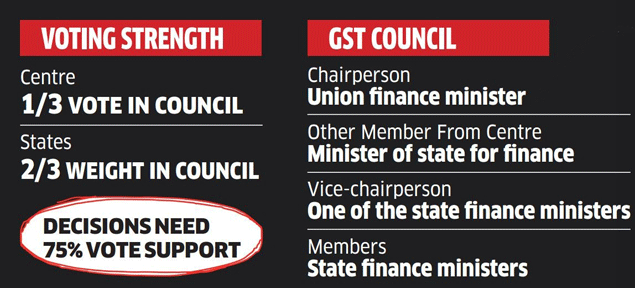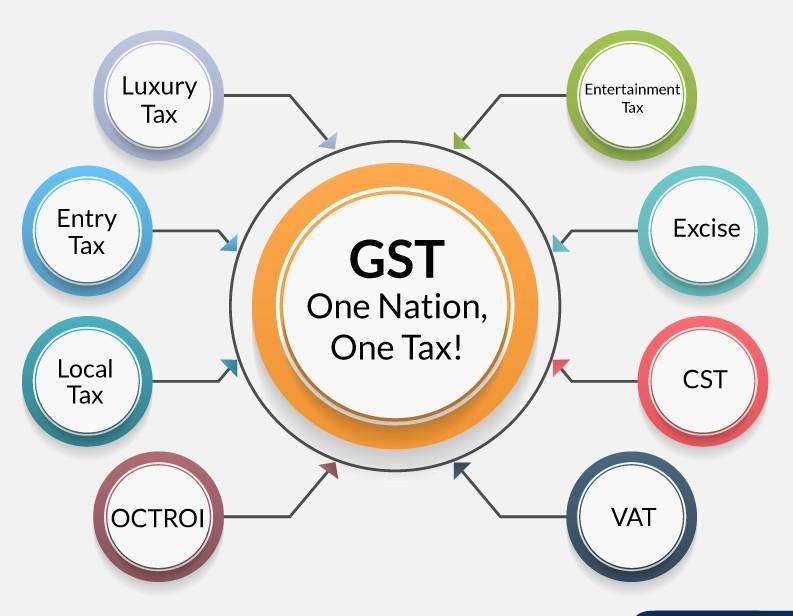GOODS & SERVICES TAX
- GST stands for Goods and Services Tax, which is an indirect tax reform that subsumes various taxes levied by the Centre, the States, and the local bodies on goods and services.
- GST was introduced through the 101st Constitution Amendment Act, 2016, with the slogan of ‘One Nation One Tax’.
- GST is based on the principle of concurrent powers, which means that both the Centre and the States have the authority to levy and collect GST on the supply of goods and services within their respective jurisdictions.
- Article 246A of the Constitution empowers the Parliament and the State Legislatures to make laws with respect to GST, subject to certain exceptions and conditions.
- Article 269A of the Constitution provides for the levy and collection of GST on inter-State supply of goods and services by the Centre, and the apportionment of the tax between the Union and the States as per the recommendations of the GST Council.
Article 279A of the Constitution establishes the GST Council, which is a constitutional body that makes recommendations to the Union and the States on various aspects of GST, such as the tax rates, exemptions, laws, and principles of levy and apportionment.
GST COUNCIL

GST Council is a constitutional body that makes recommendations to the Union and the States on important issues related to GST, such as the tax rates, exemptions, laws, and principles of levy and apportionment.
GST Council consists of the :
- Union Finance Minister as the chairperson,
- the Union Minister of State in charge of Revenue or Finance,
- and the Ministers in charge of Finance or Taxation or any other Minister nominated by each State government as members.
- The Chairperson of the Central Board of Excise and Customs (CBEC) as a permanent invitee (without voting);
- The Secretary of the Revenue Department will be the EX-Officio Secretary to the GST Council.
- GST Council also elects one of its members as the vice-chairperson for a period decided by the Council.
- GST has a four-tier tax structure for all goods and services under the slabs of 5%, 12%, 18%, and 28%. Some goods and services are also exempted from GST or taxed at a special rate.
Here are some examples of goods and services that are exempted or have special rates under GST:
Goods that are exempted from GST include:
- Fresh fruits and vegetables
- Unbranded natural honey and milk
- Salt and jaggery
- Live animals and meat
- Printed books and newspapers
- Handloom and khadi fabrics
- Sanitary napkins and contraceptives
- Judicial, non-judicial and court fee stamps
- Human blood and its components
Goods that have special rates under GST include:
- Gold, silver, and other precious metals: 3%
- Rough diamonds: 0.25%
- Cigarettes, tobacco, and pan masala: 28% + cess
- Aerated drinks and motor vehicles: 28% + cess
- Electric vehicles (EVs) is 5%
GST is a consumption-based tax, which means it is levied at the point of final consumption. The place of supply determines where the goods and services are taxed.
GST aims to
1. simplify the tax system,
2. eliminate cascading taxes,
3. reduce compliance costs, and
4. enhance revenue collection.
It also seeks to create a common national market and promote economic growth and development.
The weightage of the vote of the Centre is one-third of the total votes, and the weightage of the votes of all the States taken together is two-thirds of the total votes. Decisions are taken by consensus or by a three-fourths majority of the weighted votes of the members present and voting.

